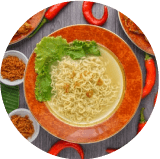Tasting a wine: olfactory analysis
The sense of smell is one of the least used and stimulated senses. For this reason, the olfactory analysis may seem a particularly complex phase of tasting , but it is above all an opportunity to regain possession of a “dormant” sensory capacity , able to tell the fascinating reality of the world of perfumes . The substances responsible for the aromas are defined as "volatile" , because they have the property of evaporating from the liquid part in which they are dissolved.
Based on the origin, the aromas are classified as primary, secondary and tertiary . The primary or varietal aromas depend on chemical substances - terpenes - already present in the original grape in the external part of the pulp of the grape and in the skin. Some vines , defined as “aromatic”, are particularly rich in these substances which are transferred directly into the wine without being dispersed during the winemaking process . This is the case, for example, of Muscat grapes , with the typical aromas of sage and of the aromatic traminer, with the unmistakable notes of rose.
The secondary aromas , generated during the fermentation process and in the immediately following phase, can be fruity (peach, banana ...), floral (acacia, hawthorn ...), fermentative (yeast, bread crust ...) milky (butter, cream ...), herbaceous-vegetable or vinous, to remember the must . They are fresh, fragrant aromas, which characterize the youthful phase of the wine and fade over time. Finally, the tertiary aromas are formed during aging and recall spicy (black pepper, clove ...), balsamic (mint, eucalyptus ...), mineramatic (toasted, roasted ...), animal ( leather, fur ...) ethereal (wax, enamel, china ...).
During aging , even the fruity, floral and herbaceous hints take on more complex characteristics, highlighting aromas of ripe fruit , cooked, in jam, in alcohol, dried, candied, aromas of dried , withered, macerated flowers , dried herbs, dry hay, tobacco , undergrowth, mushroom , humus. The substances responsible for these aromas are many and are hardly remembered for the chemical name, but thanks to the correspondence , the association with known perfumes, belonging to the very personal baggage of olfactory memories . In fact, a great way to easily identify a perfume is to associate it with a memory. This allows us to overcome the moment that grants the sensation of a perfume but not its perception, the moment in which we “feel” an aroma, but we cannot remember “what it is”, to translate it and to give it a name. It is meticulous work, but also a lot of fun .
The olfactory analysis does not only concern the recognition of aromas , but also the evaluation of their intensity, complexity and overall quality. Intensity is the olfactory quantity , that is the difference that passes, for example, between the aromatic impact offered by a rose rather than an entire bouquet of roses. The complexity is given by the more or less articulated succession of aromatic families that make up the olfactory picture, while the quality of the aromas is greater the more they are intact, well defined, typical, pleasant, well harmonized, without prevarication and, above all, free from unpleasant odors deriving from defects in the wine (cork, oxidized, sour, etc.). The aromas should first be appreciated when the glass is still , inhaling intensely in order to catch the most subtle and fleeting hints , then, by swirling the glass, you can perceive the aromas released by aeration and oxidation . But beware of addiction!







